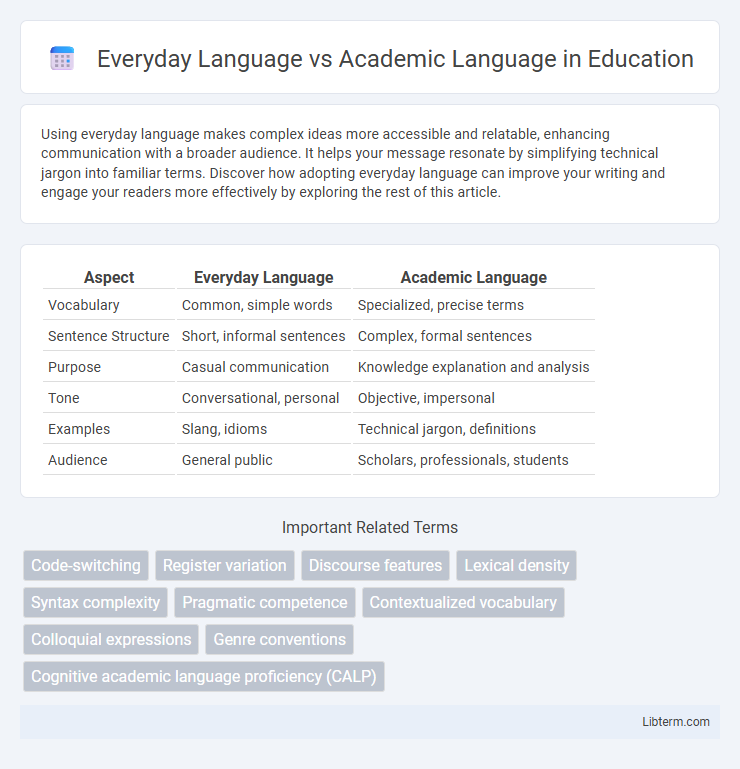Using everyday language makes complex ideas more accessible and relatable, enhancing communication with a broader audience. It helps your message resonate by simplifying technical jargon into familiar terms. Discover how adopting everyday language can improve your writing and engage your readers more effectively by exploring the rest of this article.
Table of Comparison
| Aspect | Everyday Language | Academic Language |
|---|---|---|
| Vocabulary | Common, simple words | Specialized, precise terms |
| Sentence Structure | Short, informal sentences | Complex, formal sentences |
| Purpose | Casual communication | Knowledge explanation and analysis |
| Tone | Conversational, personal | Objective, impersonal |
| Examples | Slang, idioms | Technical jargon, definitions |
| Audience | General public | Scholars, professionals, students |
Introduction to Everyday and Academic Language
Everyday language consists of informal, conversational words and phrases used in daily interactions, reflecting personal experiences and social contexts. Academic language employs specialized vocabulary, complex sentence structures, and formal tone to convey precise ideas and support critical thinking in educational settings. Mastery of academic language is essential for success in reading, writing, and comprehension across various disciplines.
Defining Everyday Language
Everyday language consists of informal, conversational vocabulary and structures used in daily interactions, emphasizing simplicity and clarity. It often includes idiomatic expressions, slang, and context-dependent meanings that are easily understood in familiar social settings. This type of language contrasts with academic language, which demands precision, formal grammar, and specialized terminology for clarity in scholarly communication.
Characteristics of Academic Language
Academic language features precise vocabulary, formal tone, and complex sentence structures to convey clear and specific meanings. It emphasizes subject-specific terminology, logical organization, and evidence-based reasoning to support arguments. Mastery of academic language enhances comprehension and communication in scholarly contexts.
Key Differences Between Everyday and Academic Language
Everyday language is informal, context-driven, and relies on idiomatic expressions, while academic language is formal, precise, and structured to convey complex ideas clearly. Academic language emphasizes discipline-specific vocabulary, objective tone, and evidence-based reasoning, contrasting with the conversational and subjective nature of everyday speech. Understanding these differences helps improve communication skills critical for academic success and professional environments.
Importance of Context in Language Use
Everyday language features informal vocabulary and simple sentence structures suited for casual interactions, while academic language employs specialized terminology and complex syntax designed for precise communication in scholarly contexts. The importance of context in language use lies in selecting appropriate registers to ensure clarity and effectiveness, as misapplication can lead to misunderstanding or reduced credibility. Understanding the distinction between everyday and academic language is crucial for adapting discourse to audience expectations and communicative goals.
Vocabulary: Common vs Specialized Terms
Everyday language relies on common vocabulary that is easily understood by a broad audience, using simple words and phrases found in daily conversations. Academic language, by contrast, incorporates specialized terms and discipline-specific jargon that convey precise meanings and support complex ideas within scholarly or professional contexts. Mastery of these specialized terms enhances comprehension and communication in academic settings, distinguishing it from general everyday speech.
Grammar and Structure Distinctions
Everyday language typically features simple sentence structures, informal grammar, and colloquial expressions that prioritize ease of communication. Academic language relies on complex syntax, precise grammar, and specialized vocabulary to convey complex ideas clearly and professionally. These distinctions in grammar and structure are essential for effective communication within formal scholarly contexts versus casual everyday interactions.
Code-Switching: Navigating Between Registers
Code-switching involves shifting seamlessly between everyday language and academic language to adapt to different social and educational contexts. This skill enhances communication effectiveness by aligning vocabulary, sentence structure, and discourse style with the demands of formal academic settings versus informal conversations. Mastery of code-switching supports cognitive flexibility and academic success by enabling clear expression and comprehension across diverse linguistic registers.
Impact on Learning and Communication
Everyday language features informal vocabulary and conversational syntax that support quick social interaction but can limit precision and depth of understanding in academic settings. Academic language involves specialized terminology, complex sentence structures, and explicit logical relationships that enhance critical thinking, comprehension, and knowledge retention. Mastery of academic language skills directly improves students' ability to engage with complex texts, participate in scholarly discussions, and perform successfully in assessments.
Strategies for Developing Academic Language Skills
Effective strategies for developing academic language skills include immersive reading of scholarly texts, targeted vocabulary instruction emphasizing domain-specific terms, and structured writing practice tailored to academic conventions. Utilizing collaborative discussions and explicit grammar instruction enhances comprehension and expression within formal contexts. Integrating technology-based tools, such as academic writing software and language learning apps, supports continuous skill development and feedback.
Everyday Language Infographic

 libterm.com
libterm.com